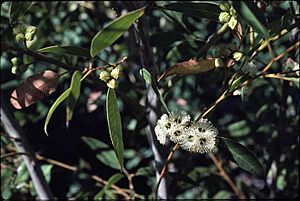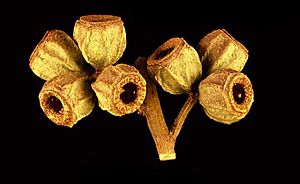Boranup mallee facts for kids
Quick facts for kids Boranup mallee |
|
|---|---|
 |
|
| Scientific classification | |
| Genus: |
Eucalyptus
|
| Species: |
calcicola
|
The Eucalyptus calcicola, also known as the Boranup mallee, Harry Butler's mallee, or Hamelin Bay mallee, is a special type of eucalyptus. It grows only in a small part of Western Australia. This plant has smooth, pale green bark. Its leaves are shaped like spears or are slightly curved. It has white flowers that grow in groups, and its fruit is ribbed and shaped like a cup.
What it Looks Like
The Boranup mallee is a type of mallee, which means it's a shrub-like eucalyptus with many stems. It can grow between 2.5 and 8 meters (8 to 26 feet) tall. This plant has a special woody swelling at its base called a lignotuber. This helps it regrow after fires.
Its bark is smooth and pale greenish-grey. It peels off in strips. Young plants have leaves that grow in opposite pairs. These leaves are broadly egg-shaped, about 45–90 mm (1.8–3.5 in) long and 30–67 mm (1.2–2.6 in) wide. They attach directly to the stem without a stalk.
Adult leaves are different. They grow one after another, not in pairs. They are shaped like a spear or are slightly curved. These leaves are 60–110 mm (2.4–4.3 in) long and 12–20 mm (0.47–0.79 in) wide. They have a stalk (called a petiole) that is 13–25 mm (0.51–0.98 in) long. Both sides of the adult leaves are a slightly shiny mid-green.
The flower buds grow in groups of seven or nine. They are on a flattened stalk called a peduncle, which is 12–18 mm (0.47–0.71 in) long. Each individual bud has a small stalk (a pedicel) up to 6 mm (0.24 in) long. The mature buds are oval, 9–15 mm (0.35–0.59 in) long and 5–9 mm (0.20–0.35 in) wide. They have a cone-shaped cap called an operculum.
The Boranup mallee flowers between January and June. Its flowers are white. After flowering, it produces a woody, cup-shaped fruit. This fruit is called a capsule. It is 9–13 mm (0.35–0.51 in) long and 11–15 mm (0.43–0.59 in) wide. The seed-releasing parts (valves) are below the rim of the fruit.
How it Got its Name
The Eucalyptus calcicola was first officially described in 1974. A scientist named Ian Brooker wrote about it. He used a plant sample collected by K.M Allen in 1971 near Cape Freycinet. This description was published in a science journal called Nuytsia.
The name calcicola comes from two Latin words. "Calci" means "limestone" and "cola" means "dweller." So, calcicola means "limestone dweller." This name tells us where this plant likes to live.
In 2002, another scientist named Dean Nicolle described two types, or subspecies, of Eucalyptus calcicola:
- Eucalyptus calcicola subsp. calcicola: This type has fruit with strong ribs. Its fruit is 12–16 mm (0.47–0.63 in) across.
- Eucalyptus calcicola subsp. unita: This type has fruit with weaker ribs. Its fruit is 10–12 mm (0.39–0.47 in) across. The name unita means "united" in Latin. It suggests this subspecies connects calcicola with another plant called E. ligulata.
Where it Lives
The Eucalyptus calcicola subsp. calcicola mostly grows on limestone sand dunes. You can find it along the far south coast of Western Australia. It grows between Cape Freycinet and Cape Hamelin.
The Eucalyptus calcicola subsp. unita grows in a different area. It is found between Point Hillier near Denmark and Bremer Bay.
Protecting the Boranup Mallee
Both subspecies of Eucalyptus calcicola are considered "Priority Four" plants. This classification comes from the Government of Western Australia's Department of Parks and Wildlife.
"Priority Four" means that these plants are rare. However, they are not currently in immediate danger of disappearing. They are monitored to make sure their populations stay healthy.



